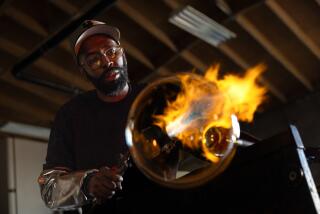This One’s a Real Glass Act
- Share via
In a world decked in the plain and the plainer, Christopher Radko is the guy who swooped in 13 years ago like some Yuletide Ralph Lauren and tapped into our yearning for tradition--even if that tradition is as newly minted as a Wall Street IPO.
In place of ordinary bells and balls, he has created ornaments as witty as Santa on a Harley, as whimsical as a feathered Madame Pompadour, as venerated as the Baby Jesus in the manger and all with the color and confection of a Christian Lacroix ball gown.
“He is single-handedly responsible for bringing back molded-glass ornaments in the tradition of how things were 80 years ago,” says Charles Goldfine, an ornament buyer for Saks Fifth Avenue. “Sure, there were people who were doing molded-glass all along, but they were little and didn’t have the vision Christopher had. Not only did he bring a talent for creation, but he brought a little showmanship to the whole thing, too.”
Spurred by little more than his Polish grandmother’s rebuke when he toppled the family tree in 1983 (“Chris has ruined Christmas”), Radko has transformed ornaments from seasonal specialty to seasonless collectible. And, in the process, he created an empire that churns out 2 million baubles a year for every holiday and event imaginable.
Now, in addition to pricey ornaments--the average Radko costs $36--there are Radko snow globes, Radko greeting cards, Radko wrapping paper, neckties and figurines. This year he’s added his first book, “Christopher Radko’s Ornaments” (Clarkson Potter, $22.50).
He’s decorated Vice President Al Gore’s mansion (with Tipper at his side) and President Clinton’s mantle. (One year, he crafted a glass Chelsea-in-a-tutu for the first family.) He’s cultivated fans such as Whoopi Goldberg, Arnold Schwarzenegger, Barbra Streisand and Manhattan restaurateur Warner Leroy, whose stash totals about 4,000 ornaments.
But perhaps the surest measure of Radko’s success is the copycats he’s spawned and the aura of celebrity he’s created--how many other ornament-makers have been mobbed in the rarefied halls of Saks and Bloomingdale’s?
Lifting Spirits With Glamour, Magic
Certainly the 39-year-old designer adores the frenzy. But he’s also determined to cast Radko-mania in a deeper context.
“My favorite period was the ‘20s and ‘30s--all the sparkle and glamour of Fred and Ginger, of Busby Berkeley musicals,” he says, settling into a sofa in his Fifth Avenue showroom, which is done up like a glistening Victorian parlor on Christmas Eve.
“My ornaments try to reflect some of that sparkle and magic. Those musicals were created to raise people’s spirits during the Depression. And I’d like to think the purpose of my work is to lift spirits, to remind people that there is more to life than just the daily grind.
“On an emotional level, ornaments are a way to connect to each other, through the warm memories and feelings they evoke.”
Of course, there may be no better advertisement for the warm fuzzies than Radko himself. With his blond hair, hazel eyes and red turtleneck sweater, he could be a guest in some glossy Martha Stewart Christmas spread: Perfectly polished and perfectly poised, he greets showroom visitors with a firm handshake.
But there’s a bit of the Hallmark greeting card in him, too, particularly as he spins images of his childhood Christmases.
“My favorite time was coming home from school and doing my homework under the tree,” says Radko, who grew up in Scarsdale, N.Y., and is the son of two doctors. “I’d duck under the branches and look up into the tree and get lost in the wonderland of glass comets and Santas-on-a-spaceship.”
But for all his unabashed sentimentality, he also wears his ambition on his gray flannel coat sleeve.
“Each year, there are 50 million Christmas trees in the United States. My goal is to have an ornament on every tree,” he says. “As for expanding the brand, I’ll be recognized one day as the finest gift and decorating resource for holidays throughout the year. That is my destiny.”
Heady stuff for a guy who literally fell into Christmas or, to be more precise, whose family tree did. By now the tale of the Radko tree and the company it spawned is becoming as ingrained in holiday lore as the legend of St. Nicholas himself.
It started with his parents’ old tree stand, which Radko was assigned to clean every year. But in 1983, in a burst of modernist inspiration, he swapped the rusty cast-iron piece for a new aluminum model. Problem was, it wasn’t strong enough to handle the weight of a 14-foot tree. And so, the day after it went up, the tree came crashing down, smashing hundreds of glass ornaments, many of which dated from his great-grandmother’s time.
Radko, who at the time was a $12,000-a-year mail clerk with an art history degree from Columbia University, set out to replace what he’d destroyed. But reality was that, in the America of the 1980s, Old World ornaments made of glass were not being sold.
“They died off in the early ‘70s,” Radko says. “The bulk of the American Christmas-decorating trade was in department stores, and as stores consolidated, they looked at the bottom line and saw it was cheaper to import ornaments from the Orient, where there was no tradition of glass-making. Instead, there was plastic and Styrofoam, the materials of the Atomic Age.”
Stumbling on to Something
The following spring, on a visit to Poland, Radko found a retired glassblower who could re-create some of the ornaments--globes, reflectors, icicles. But before he could present them to his grandmother, his friends begged to buy them, and Radko realized he might be on to something. His first collection debuted in 1986 with 50 designs; this year’s tops 700.
For now, there seems to be no end to the stream. While Radko fans are snapping up this season’s wares--not surprisingly, millennium designs are the hottest sellers--he already has completed Christmas 2000 and is mapping out 2001.
Whatever shape it takes--and he’s not saying--the collection will be brought to life by 2,000 artisans in Poland, Germany, Italy and the Czech Republic. Though ornament-making is still a cottage industry--every eyelash is painted by hand--Radko says it is light-years beyond his early days, when the difficulties of offshore manufacturing were compounded by the realities of working in communist nations, where delivery schedules and production standards often took on a different meaning.
“People didn’t always understand that if you order a red Santa, they can’t send a green one,” he laughs. “But they had the desire to make things work.”
So much so, he says, that the newfound popularity of Old World ornaments has helped revive a craft that was on the verge of dying.
“When I started, the average age of a glassblower was 67 or 70; it’s now 25.”
What his artisans produce is limited only by Radko’s licensing, imagination and seemingly boundless energy. He spends six months a year on the road, visiting artisans, bonding with fans, hawking on QVC and scouring for a tree--any tree--that might be Radko-less.
“He’s made himself into this person. He lives, breathes and eats ornaments,” says Ruth Wolf, the owner of the Limited Edition in Merrick, N.Y., who has been selling ornaments for a quarter-century. Like others, she describes Radko as an “extraordinary” promoter. “He is truly one of the stars. There are other companies that make ornaments, but no one is Christopher Radko--and it’s not just because of the ornaments.”
Tales of mobs and marketing are legion.
“He’s become a victim of his own success,” says Goldfine of Saks, who says his Radko business has grown 100% in the five years since Saks began carrying the line. “The last time he did PAs [personal appearances] in the stores as a matter of course was 1996. Word would get out that he would be in the store and people would line up at the front door so they could be the first in.”
And it’s not just marquee venues. Wolf says that Radko showed up for a personal appearance at her shop last year to sign new ornaments--and old ones. “He made it into a charity event: If you wanted him to autograph an old ornament, you had to give him a $25 check that would go to the charity of our choice, which, in this case, was United Cerebral Palsy. We raised $2,500 in under two hours.”
Indeed, charity has become an important element of Radko’s work. Each year, he creates a collection of fund-raising ornaments--AIDS, breast cancer and pediatric cancer are continuing beneficiaries; new ones, such as the Elton John Foundation, are added from year to year.
“I came to a point in my life where I realized I had established a successful business at an early age, and I wondered what would be my next challenge. A new business? . . . I didn’t have the impetus of needing more money to pay the rent or to prove myself,” he says.
Perhaps. But while he estimates he’s raised $3 million to $4 million for charity, he’s clearly not finished proving himself.
The Joy of Putting Up a Tree
What does Christopher Radko want? To be the next Hallmark--in spirit, if not in size.
“Say Valentine’s Day is coming up,” he says. “If a husband wants to buy something great, he could think Godiva for chocolate, Hallmark for a card, and if he wants to give an art gift, I want him to think Radko.”
Which isn’t to say Radko is about to abandon Christmas, which accounts for about 70% of his business. To the contrary, he is relentless in his mission to get Americans to share his childlike passion for it.
“Christmas isn’t about creating a perfect environment. There’s no room for humanity in perfection. We express our uniqueness through a multitude of little imperfections that are sweet and beautiful,” he says. And what if, despite the best intentions, the tree, uh, topples over?
Radko, whose tempered-glass ornaments are thicker than the old antique ones, laughs.
“People report that if they fall on the carpet, they won’t break,” he says. “But I’d tell you to get a good tree stand and tie the tree to the wall and anchor it so it doesn’t fall over.”






